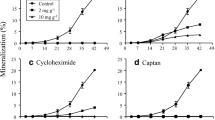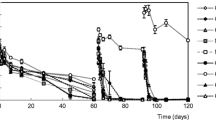Abstract
Purpose
Previous investigations—field samplings and laboratory experiments—support the hypothesis that the degradation of s-triazines is enhanced in previously exposed as compared to pristine soils in terrestrial environments. Despite this, bottlenecks of soil sampling and various soil modification practices in microcosm studies have made it difficult to guarantee that previous contamination history enhances contaminant degradation regardless of soil origin in terrestrial ecosystems. We test the hypothesis that the degradation of simazine (2-chloro-4,6-bis(ethylamino)-s-triazine) is enhanced in previously exposed soils as compared to pristine soils in 10 l buckets at the mesocosm scale.
Materials and methods
We collected soil at three separate sites consisting of a previously exposed and a pristine field. At every field, soil was collected at three separate plots and simazine degradation (days 0 and 65) and the response to atzB degrader gene primers (days 0 and 110) were followed. We analyzed the results using analysis of covariance (ANCOVA). Previous exposure and field site were assessed as fixed factors and initial simazine concentration and abiotic soil conditions as covariates.
Results and discussion
After the 65-day exposure, remaining simazine concentrations depended on previous exposure but not on collection site. The response to atzB gene primers was positive in all mesocosms where simazine degradation had been rapid. Soil moisture, pH, and organic matter content were insignificant. If soil moisture was not included in the ANCOVA model, previous exposure did not appear as a significant factor.
Conclusions
The results support the hypothesis that simazine is degraded more rapidly in previously exposed soils as compared to pristine environments, provided that degradation genes are available. Previously exposed soil might be used to enhance the degradation of simazine in recently contaminated terrestrial soils, supposing that the central requirements for microbial growth are adequate.


Similar content being viewed by others
References
Abdelhafid R, Houot S, Barriuso E (2000) How increasing availabilities of carbon and nitrogen affect atrazine behaviour. Biol Fertil Soils 30:333–340
Avery SV (2006) Microbial cell individuality and the underlying sources of heterogeneity. Nat Rev Microbiol 4:577–587
Bacci E, Renzoni A, Gaggi C, Calamari D, Franchi A (1989) Models, field studies, laboratory experiments: an integrated approach to evaluate the environmental fate of atrazine (s-triazine herbicide). Agric Ecosyst Environ 27:513–522
Behki R, Topp E, Dick W, Germon P (1993) Metabolism of the herbicide atrazine by Rhodococcus strains. Appl Environ Microbiol 59:1955–1959
Chelinho S, Moreira-Santos M, Lima D, Silva C, Viana P, André S, Lopes I, Ribeiro R, Fialho AM, Viegas CA, Sousa JP (2010) Cleanup of atrazine-contaminated soils: ecotoxicological study on the efficacy of a bioremediation tool with Pseudomonas sp. ADP. J Soils Sediment 10:568–578
De Souza ML, Seffernick J, Martinez B, Sadowsky MJ, Wackett LP (1998) The atrazine catabolism genes atzABC are widespread and highly conserved. J Bacteriol 180:1951–1954
Devers M, Soulas G, Martin-Laurent F (2004) Real-time reverse transcription PCR analysis of expression of atrazine catabolisim genes in two bacterial strains isolated from soil. J Microbiol Methods 56:3–15
Devers M, Henry S, Hartmann A, Martin-Laurent F (2005) Horizontal gene transfer of atrazine-degrading genes (atz) from Agrobacterium tumefaciens St96-4 pADP1:Tn5 to bacteria of maize-cultivated soil. Pest Manag Sci 61:870–880
Fairchild JF, Sappington LC (2002) Fate and effects of the triazinone herbicide metribuzin in experimental pond mesocosms. Arch Environ Contam Toxicol 43:198–202
García-González V, Govantes F, Shaw LJ, Burns RG, Santero E (2003) Nitrogen control of atrazine utilization in Pseudomonas sp. Strain ADP. Appl Environ Microbiol 69:6987–6993
Gentry TJ, Josephson KL, Pepper IL (2004) Functional establishment of introduced chlorobenzoate degraders following bioaugmentation with newly activated soil. Biodegradation 15:67–75
Hamer U, Marschner B (2002) Priming effects of sugars, amino acids, organic acids and catechol on the mineralization of lignin and peat. J Plant Nutr Soil Sci 165:261–268
Huggins DG (1990) Ecotoxic effects of atrazine on aquatic macroinvertebrates and its impact on ecosystem structure. University of Kansas, Ph. D. Dissertation, Lawrence, KS
Joner EJ, Hirmann D, Szolar OH, Todorovic D, Leyval C, Loibner AP (2004) Priming effects on PAH degradation and ecotoxicity during a phytoremediation experiment. Environ Poll 128:429–435
Kauppi S, Sinkkonen A, Romantschuk M (2011) Enhancing bioremediation of diesel-fuel-contaminated soil in a boreal climate: comparison of biostimulation and bioaugmentation. Int Biodeterior Biodegrad 65:359–368
Kauppi S, Romantschuk M, Strömmer R, Sinkkonen A (2012) Natural attenuation is enhanced in previously contaminated and coniferous forest soils. Environ Sci Pollut Res. doi:10.1007/s11356-011-0528-y
Koivula TT, Salkinoja-Salonen M, Peltola R, Romantschuk M (2004) Pyrene degradation in forest humus microcosms with or without pine and its mycorrhizal fungus. J Environ Qual 33:45–53
Krutz LJ, Burke IC, Reddy KN, Zablotowitz RM, Price AJ (2009) Enhanced atrazine degradation: evidence for reduced residual weed control and a method for identifying adapted soils and predicting herbicide persistence. Weed Sci 57:427–434
Krutz LJ, Shaner DL, Weaver MA, Webb RMT, Zablotowicz RM, Reddy KN, Huang Y, Thomson SJ (2010) Agronomic and environmental implications of enhanced s-triazine degradation. Pest Manag Sci 66:461–481
Laine MM, Jørgensen KS (1996) Straw compost and bioremediated soil as inocula for the bioremediation of chlorophenol-contaminated soil. Appl Environ Microbiol 62:1507–1513
Lima D, Viana P, André S, Chelinho S, Costa C, Ribeiro R, Sousa JP, Fialho AM, Viegas CA (2009) Evaluating a bioremediation tool for atrazine contaminated soils in open soil microcosms: the effectiveness of bioaugmentation and biostimulation approaches. Chemosphere 74:187–192
Lytle JS, Lytle TF (2002) Uptake and loss of chlorpyrifos and atrazine by Juncus effuses L. in a mesocosm study with a mixture of pesticides. Environ Toxicol Chem 21:1817–1825
Mahía J, Cabaneiro A, Carballas T, Días-Raviña M (2008) Microbial biomass and C mineralization in agricultural soils as affected by atrazine addition. Biol Fertil Soils 45:99–105
Martín M, Gibello A, Lobo C, Nandi M, Garbi C, Fajardo C, Barra-Caracciolo A, Grenni P, Martínez-Iñigo MJ (2008) Application of fluorescence in situ hybridization technique to detect simazine-degrading bacteria in soil samples. Chemosphere 71:703–710
McGee EJ, Keatinge MJ, Synnott HJ, Colgan PA (1995) The variability in fallout content of soils and plants and the design of optimum field sampling strategies. Heal Phys 68:320–327
McGowan C, Fulthorpe R, Wright A, Tiedje JM (1998) Evidence for interspecies gene transfer in the evolution of 2,4-dichlorophenoxyacetic acid degraders. Appl Environ Microbiol 64:4089–4092
Morán AC, Müller A, Manzano M, González B (2006) Simazine treatment history determines a significant herbicide degradation potential in soils that is not improved by bioaugmentation with Pseudomonas sp. ADP. J Appl Microbiol 101:26–35
Morgante V, López-López A, Flores C, González M, González B, Vásquez M, Rosselló-Mora R, Seeger M (2010) Bioaugmentation with Pseudomonas sp. strain MHP41 promotes simazine attenuation and bacterial community changes in agricultural soils. FEMS Microbiol Ecol 71:114–126
Muyzer G, Smalla K (1998) Application of denaturing gradient gel electrophoresis (DGGE) and temperature gradient gel electrophoresis (TGGE) in microbial ecology. Antonie Van Leeuwenhoek 73:127–141
Penet S, Vendeuvre C, Bertoncini F, Marchal R, Monot F (2006) Characterisation of biodegradation capacities of environmental microflorae for diesel oil by comprehensive two-dimensional gas chromatography. Biodegradation 17:577–585
Radosevich M, Tuovinen OH (2004) Microbial degradation of atrazine in soils, sediments, and surface water. Pesticde Decontamination and Detoxification ACS Symposium Series 863:129–139
Rhine ED, Fuhrmann JJ, Radosevich M (2003) Microbial community responses to atrazine exposure and nutrient availability: linking degradation capacity to community structure. Microbial Ecol 46:145–160
Rohr JR, Kerby JL, Sih A (2007) Community ecology as a framework for predicting contaminant effects. Trends Ecol Evol 21:606–613
Runes HB, Jenkins JJ, Bottomley BJ (2001) Atrazine degradation by bioaugmented sediment from constructed wetlands. Appl Microbiol Biotechnol 57:427–432
Saijaphan K, Heepngoen P, Sadowsky MJ, Boonkerd N (2010) Arthrobacter sp. strain KU001 isolated from a Thai soil degrades atrazine in the presence of inorganic nitrogen sources. J Microbiol Biotechnol 20:602–608
Sapozhnikova Y, Pennington P, Wirth E, Fulton M (2009) Fate and transport of Irgarol 1051 in a modular estuarine mesocosm. J Environ Monit 11:808–814
Sarand I, Haario H, Jorgensen KS, Romantschuk M (2000) Effect of inoculation of a TOL plasmid containing mycorrhizosphere bacterium on development of Scots pine seedlings, their mycorrhizosphere and the microbial flora in m-toluate amended soil. FEMS Microbiol Ecol 31:127–141
Sarand I, Skärfstad E, Forsman M, Romantschuk M, Shingler V (2001) Role of the DmpR-mediated regulatory circuit in bacterial biodegradation properties in methylphenol-amended soils. Appl Environ Microbiol 67:162–171
Shapir N, Mongodin EF, Sadowsky MJ, Daugherty SC, Nelson KE, Wackett LP (2007) Evolution of catabolic pathways: genomic insights into microbial s-triazine metabolism. J Bacteriol 189:674–682
Sinkkonen A, Simpanen S, Romantschuk R (2010) An evolutionary perspective to the stimulation of bacterial activity in contaminated soil. In: Płaza G (ed) Trends in bioremediation and phytoremediation. Research Signpost, Kerala, pp 73–81
Sinkkonen A, Kauppi S, Simpanen S, Rantalainen A-L, Strömmer R, Romantschuk M (2013) Layer of organic pine forest soil on top of chlorophenol contaminated mineral soil enhances contaminant degradation. Environ Sci Pollut Res 20:1737–1745
Talja M, Kaukonen S, Kilpi-Koski J, Malin I, Tuominen J, Romantschuk M, Kairesalo T, Kontro M (2008) Atrazine and terbutryn degradation in deposits from groundwater environment within the boreal region in Lahti, Finland. J Agric Food Chem 56:11962–11968
van Veen JA, van Overbeek LS, van Elsas JD (1997) Fate and activity of microorganisms introduced into soil. Microbiol Mol Biol Rev 61:121–135
Vibber LL, Presler MJ, Colores GM (2007) Isolation and characterization of novel atrazine-degrading microorganisms from an agricultural soil. Appl Microbiol Biotechnol 75:921–928
Webster R (2007) Analysis of variance, inference, multiple comparisons and sampling effects in soil research. Eur J Soil Sci 58:74–82
Acknowledgments
Two anonymous reviewers gave constructive comments. Jorma Hellstén, Hannu Neuvonen, and Markku Saari assisted in soil selection and history. Academy of Finland (decision no. 139847, AS), Suomen Luonnonvarain tutkimussäätiö (AS), Marjatta and Eino Kolli Foundation (SK, TP), Elite project funded by ERDF (MR), and the Regional Council of Päijät-Häme (MR) funded the research.
Author information
Authors and Affiliations
Corresponding author
Additional information
Responsible editor: Jean-Paul Schwitzguébel
Rights and permissions
About this article
Cite this article
Sinkkonen, A., Kauppi, S., Pukkila, V. et al. Previous exposure advances the degradation of an anthropogenic s-triazine regardless of soil origin. J Soils Sediments 13, 1430–1438 (2013). https://doi.org/10.1007/s11368-013-0742-y
Received:
Accepted:
Published:
Issue Date:
DOI: https://doi.org/10.1007/s11368-013-0742-y




